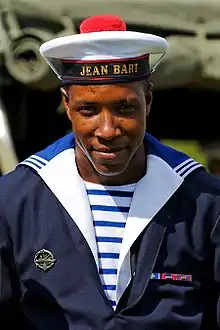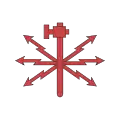Seaman (rank)
Seaman is a military rank used in many navies around the world. It is considered a junior enlisted rank and, depending on the navy, it may be a single rank on its own or a name shared by several similarly-junior ranks.

In the Commonwealth, it is the lowest rank in the navy, while in the United States, it refers to the three lowest ranks of the U.S. Navy and U.S. Coast Guard. The equivalent of the seaman is the matelot[1] in French-speaking countries, and Matrose in German-speaking countries.
Australia
The Royal Australian Navy features one seaman rank, which is split into two distinct classes. Seaman and seaman* (pronounced "seaman star"), to differentiate between those who have completed their employment training and those who are in training. There is no insignia on a seaman rank slide.
Canada
There are 4 grades of sailor (previously the term "seaman", until it was replaced with "sailor" in August 2020[2][3])/matelot in the Royal Canadian Navy:
 Sailor Third Class (previously Ordinary Seaman) or matelot de troisième classe
Sailor Third Class (previously Ordinary Seaman) or matelot de troisième classe Sailor Second Class (previously Able Seaman) or matelot de deuxième classe
Sailor Second Class (previously Able Seaman) or matelot de deuxième classe Sailor First Class (previously Leading Seaman) or matelot de première classe
Sailor First Class (previously Leading Seaman) or matelot de première classe Master Sailor (previously Master Seaman) or matelot-chef
Master Sailor (previously Master Seaman) or matelot-chef
The rank of master sailor is unique because it was created only for the Canadian Navy. It does not follow the British tradition of other Canadian ranks. It corresponds to the rank of master corporal/caporal-chef.
France
Matelot 2e classe (seaman 2nd class), or apprentice seaman, and matelot breveté (able seaman) are designations of the French Navy. Matelots are colloquially known as "mousses".
 Matelot
Matelot Matelot breveté (able seaman)
Matelot breveté (able seaman)
Germany

The German rank of "seaman" (German: Matrose) is the lowest enlisted rank of the German Navy.[4] It is equivalent to OR1 in NATO and is a grade A3 in the pay rules of the Federal Ministry of Defence.
Indonesia
In the Indonesian Navy, this rank is referred to as "kelasi". There are three levels of this rank in the Indonesian Navy which are: "seaman recruit" (kelasi dua), "seaman apprentice" (kelasi satu), and "seaman" (kelasi kepala), the rating system thus mirrors the one used in the US Navy.
 Seaman rank of the Indonesian Navy
Seaman rank of the Indonesian Navy
Italy
The Italian rank of "seaman" (Italian: comune di seconda classe) is the lowest enlisted rank of the Italian Navy equivalent in NATO to OR1.
 Badge of technics and mechanics
Badge of technics and mechanics Badge of coxswains
Badge of coxswains Badge of tracking radar operators
Badge of tracking radar operators Badge of electro-mechanics
Badge of electro-mechanics
Russia

Much Russian military vocabulary was imported, along with military advisers, from Germany in the 16th and 17th centuries. The Russian word for "seaman" or "sailor" (Russian: матрос; matros) was borrowed from the German "matrose". In Imperial Russia the most junior naval rank was "seaman 2nd class" (матрос 2-й статьи; matros vtoroi stati). Estonia (Estonian: mаdrus) and Latvia (Latvian: mаtrozis) use closely related loanwords.
The 1917 Revolution led to the term "Red Fleet man" (краснофлотец; krasnoflotets) until 1943, when the Soviet Navy reintroduced the term "seaman" (матрос; matros), along with badges of rank. The Russian Federation inherited the term in 1991, as did several other former Soviet republics, including Ukraine, Azerbaijan and Belarus, with Bulgaria using the same word and the same Cyrillic orthography.
United Kingdom
In the Royal Navy the rate is split into two divisions: AB1 and AB2. The AB2 rating is used for those who have not yet completed their professional taskbooks. The rate of ordinary seaman has been discontinued.
United States

Constructionman
variation

Fireman
variation

Airman
variation

Seaman
insignia
_130204-N-JC752-089.jpg.webp)
Seaman is the third enlisted rank from the bottom in the U.S. Navy and U.S. Coast Guard, ranking above seaman apprentice and below petty officer third class. This naval rank was formerly called "seaman first class". The rank is also used in United States Naval Sea Cadet Corps, a naval-themed uniformed youth program under the sponsorship of the Navy League of the United States.
The actual title and insignia for an E-3 varies based on the job rating to which the member will ultimately be assigned.
- Those in the general deck, technical, weapons and administrative groups (with the exception of the aviation administration men) are called "seamen" and they represent the largest group of Navy and Coast Guard personnel in pay grades E-3 and below. They wear white stripes on their blue uniforms (USN and USCG), and navy blue (black) stripes on their white uniforms (USN only).
- Those in the medical group are now called "hospitalmen." In October 2005, the USN dental technician (DT) rating was merged into the hospital corpsman (HM) rating, eliminating the "dentalman" title for E-3 and below. Those who once held the rank of "dentalman" have become "hospitalmen". They wear white stripes on their blue uniforms, and navy blue stripes on their white uniforms. After the completion of their "A" school, they wear a caduceus of the same color as the stripes on their uniforms. On their combat uniforms, a hospitalman wears their caduceus on the tab of their left collar tab. This rating was previously called pharmacist's mate (PHM) and HMs are colloquially referred to as "corpsman" in the naval service. Hospitalmen exist only in the U.S. Navy; their equivalent in the U.S. Coast Guard is the health services technician (HS), which is sourced from seamen in that service's administrative and scientific group.
- Those in the shipboard engineering and hull group, comprising conventional (USN + USCG) and nuclear (USN only) powerplants and propulsion, as well as the hull maintenance area, are called "firemen." They wear red stripes on both their USN and USCG blue uniforms and, in the case of the Navy, white uniforms.
- Those in the aviation group of the Navy and Coast Guard are called "airmen", and they wear green stripes on blue uniforms (USN + USCG) and white uniforms (USN only).
- Enlisted personnel in the construction group, which primarily populates the U.S. Navy's civil engineering construction battalions (i.e., Seabees), are called "constructionmen" and they wear light blue stripes on both their blue and white uniforms. Constructionmen are unique to the U.S. Navy; there is no U.S. Coast Guard equivalent.
No such stripes for E-1, E-2 or E-3 are authorized to be worn on working uniforms, e.g., navy work uniform, USCG operational dress uniform, coveralls, utility wear, flight suits, hospital and clinic garb, diving suits, etc. However, sailors with the pay grade of E-2 or E-3 are permitted to wear silver-anodized collar devices on their service uniforms.
Some sailors and Coast Guardsmen receive a rating following completion of a military technical training course for that particular rating known as an "A" school. Other sailors and Coast Guardsmen who have completed the requirements to be assigned a rating and have been accepted by the Navy Personnel Command/Bureau of Naval Personnel (USN) or the Coast Guard Personnel Service Center Command (USCG) as holding that rating (a process called "striking") are called "designated strikers", and are referred to by their full rate and rating in formal communications (i.e., machinist's mate fireman (MMFN), as opposed to simply fireman (FN)), though the rating is often left off in informal communications. Those who have not officially been assigned to a rating are officially referred to as "undesignated" or "non-rates." Once selected for a particular rating of their choice they become eligible for advancement in that community.
Venezuela

The rank is used by the National Bolivarian Armed Forces of Venezuela.
See also
References
- "U.S. Navy Enlisted Military Ranks | USN". Usamilitarybenefits.com. Retrieved 2013-10-02.
- https://vancouverisland.ctvnews.ca/royal-canadian-navy-to-replace-term-seaman-with-gender-neutral-sailor-1.5081892
- https://www.kamloopsthisweek.com/from-seaman-to-sailor-the-royal-canadian-navy-adopts-gender-neutral-titles-1.24193502
- Brockhaus. "Matrose". The Encyclopaedia in 24 volumes (1796–2001). 14: 3-7653-3674-2. p. 337.
External links
 Media related to Seamen at Wikimedia Commons
Media related to Seamen at Wikimedia Commons
